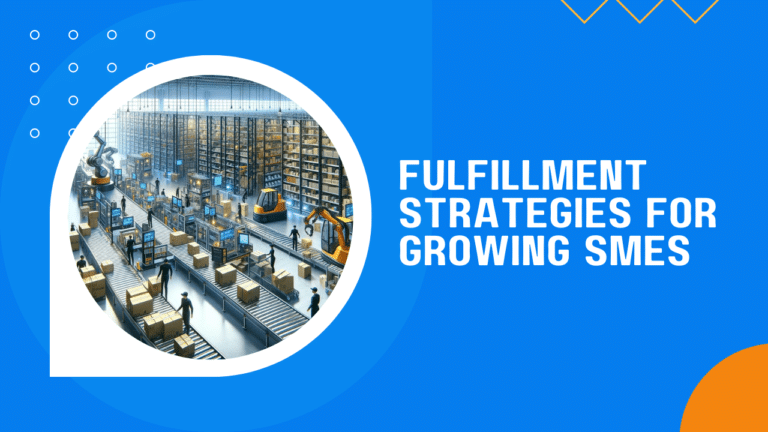Expanding a business is an adventure filled with excitement and challenges. For small to medium-sized enterprises (SMEs) dreaming big, scaling operations is not just about increasing sales or broadening product lines; it’s about mastering the art of fulfillment.
This journey demands more than just ambition; it requires a strategy finely tuned to the dynamics of growth and customer expectations.
At the heart of every successful expansion story lies the unsung hero of business operations: fulfillment. It’s the backbone that supports every order, ensuring products move from warehouse shelves into the hands of eager customers efficiently and reliably.
Yet, as SMEs venture into the broader market landscape, they often encounter a complex maze of inventory management, order processing, and shipping logistics. These challenges can swiftly transform an exciting growth opportunity into an overwhelming operational puzzle.
Recognizing the pivotal role of fulfillment in scaling efforts is the first step towards sustainable growth. This article aims to serve as your compass, guiding SME owners through the intricacies of developing and implementing fulfillment strategies that not only meet the demands of a growing business but also elevate customer satisfaction and loyalty.
By navigating these waters wisely, SMEs can turn the tide in their favor, ensuring that their scaling journey is marked by success and stability.
Understanding the Fulfillment Challenges in Scaling SMEs

As small to medium-sized enterprises embark on the path of expansion, they face a myriad of operational hurdles. Fulfillment, the critical process of getting products from your business to your customers, often becomes a complex challenge that can significantly impact growth and customer satisfaction.
Let’s explore the common fulfillment challenges that SMEs encounter as they scale up.
Navigating Inventory Management
One of the first obstacles in scaling fulfillment operations is managing inventory efficiently. As your product range expands and order volumes increase, the risk of overstocking or facing stockouts rises.
An overstock situation ties up capital that could be used for other growth activities, while stockouts can lead to missed sales opportunities and disappointed customers.
Balancing just the right amount of inventory requires a keen understanding of demand forecasting and inventory turnover rates.
Streamlining Order Processing
With growth comes a higher volume of orders, and each order demands accuracy and speed in processing. Manual processing methods that worked for a smaller scale can quickly become untenable, leading to errors and delays. These inefficiencies not only strain internal resources but also erode customer trust.
Automating order processing becomes essential, ensuring that orders are fulfilled accurately and promptly, keeping customers satisfied and coming back for more.
Optimizing Shipping and Logistics
Shipping and logistics pose another significant challenge. As SMEs grow, they often need to ship to a broader geographic area, sometimes even internationally. This expansion introduces complexities in choosing the right shipping partners, negotiating rates, and managing logistics operations efficiently.
Additionally, customers today expect fast, if not immediate, delivery times along with transparency in the shipping process. Meeting these expectations requires a robust logistics strategy that can adapt to changing needs and scale with your business.
Balancing Cost with Quality
Cost management is crucial for SMEs, and fulfillment operations are a significant expense. As businesses scale, the cost of fulfillment can spiral if not carefully managed. Finding the balance between providing high-quality, speedy fulfillment and maintaining manageable costs is a delicate dance.
This balance involves strategic decisions about in-house versus outsourced fulfillment, shipping methods, and technological investments.
Adapting to Technology
Technology plays a pivotal role in scaling fulfillment operations efficiently. However, adopting new technologies comes with its own set of challenges. SMEs must evaluate various technology platforms for inventory management, order processing, and logistics to find those that best fit their needs.
This evaluation requires understanding the features, integration capabilities, and scalability of these platforms, which can be a daunting task for businesses without extensive IT expertise.
By recognizing and addressing these challenges head-on, SMEs can create a solid foundation for their fulfillment operations, paving the way for successful scaling. The next sections will delve into strategies and solutions to overcome these obstacles, ensuring your business can grow seamlessly and sustainably.
The Pillars of Efficient Order Fulfillment for Growing Businesses
Scaling success for SMEs significantly hinges on mastering the art of efficient fulfillment. This mastery is built on several key pillars that ensure operations can grow smoothly while maintaining or even enhancing customer satisfaction. Here’s a deep dive into these essential elements.
Inventory Management: A Delicate Balancing Act
Efficient inventory management is crucial for growing businesses. It involves more than just keeping track of what’s in stock; it’s about predicting what will be in demand, minimizing waste, and maximizing turnover. Adopting a robust inventory management system can automate many of these tasks, providing real-time insights into stock levels, trends, and alerts for low stock or fast-moving items.
This automation allows for more accurate forecasting, preventing overstocking or stockouts and ensuring you can meet customer demand without tying up unnecessary capital.
Order Processing: The Speed and Accuracy Formula
As order volumes increase, the potential for errors and delays also rises. Implementing an automated order processing system can dramatically improve the speed and accuracy of this operation. Such systems streamline the entire order fulfillment process, from order entry to picking, packing, and shipping.
Automation reduces human error, speeds up processing times, and allows for better tracking and updating of order statuses. This efficiency not only optimizes internal operations but also enhances the customer experience with faster delivery times and accurate order fulfillment.
Shipping and Logistics: Navigating the Complexity
Expanding your shipping and logistics capabilities is essential for scaling SMEs. This expansion involves selecting the right partners, negotiating favorable rates, and ensuring a seamless logistics operation that can adapt to different regions and shipping requirements.
A multi-carrier shipping strategy often proves beneficial, allowing businesses to choose the best carrier for each shipment based on cost, destination, and delivery speed.
Furthermore, integrating advanced shipping software can provide real-time shipping quotes, automate carrier selection, and offer customers tracking information, thereby improving transparency and satisfaction.
Leveraging Technology for Competitive Advantage
Technology is the backbone of efficient fulfillment strategies. Investing in the right technology stack—such as Warehouse Management Systems (WMS), Order Management Systems (OMS), and Customer Relationship Management (CRM) solutions—can significantly enhance operational efficiency.
These systems not only automate and streamline processes but also provide valuable data insights for continuous improvement. The key is to choose scalable solutions that can grow with your business and integrate seamlessly with your existing tools and platforms.
Creating a Customer-Centric Fulfillment Experience
Ultimately, the goal of optimizing fulfillment is to provide a stellar customer experience. This means not only ensuring products are in stock and orders are delivered promptly but also offering flexible shipping options, easy returns, and responsive customer service.
A customer-centric approach to fulfillment can differentiate your SME in a crowded market, fostering loyalty and repeat business.
By solidifying these pillars of efficient fulfillment, SMEs can create a robust foundation for scaling their operations. With the right strategies and tools in place, businesses can navigate the challenges of growth, ensuring they can meet increased demand without compromising on service quality or operational efficiency.
Leveraging Technology in Fulfillment Strategies
For SMEs aiming to scale successfully, embracing technology in fulfillment strategies is not just an option—it’s a necessity. The right technological tools can transform complex challenges into streamlined processes, enabling businesses to grow efficiently and maintain a competitive edge.

Here’s how leveraging technology can make a significant difference in fulfillment strategies for growing SMEs.
Essential Tech Tools for Scaling Fulfillment
Warehouse Management Systems (WMS): A WMS can revolutionize how you manage your inventory, offering real-time data on stock levels, location, and movements within the warehouse. This system optimizes picking and packing processes, reduces errors, and speeds up fulfillment, ensuring that your warehouse operations can scale with your business.
Order Management Systems (OMS): An OMS acts as the command center for your orders, integrating sales channels, order processing, and customer data into one platform. It automates order routing, facilitates multi-channel fulfillment, and provides comprehensive visibility into the order lifecycle. This integration is crucial for managing increased order volumes efficiently.
Customer Relationship Management (CRM) Systems: A CRM system enhances the fulfillment process by providing detailed insights into customer behavior, preferences, and feedback. This information can be used to personalize the customer experience, forecast demand more accurately, and improve service quality.
Shipping and Logistics Platforms: Advanced shipping platforms automate carrier selection, generate shipping labels, and provide customers with tracking information. These platforms can integrate with your WMS and OMS, creating a seamless fulfillment process from warehouse to delivery.
Case Study: SME Success Through Technology Integration
To illustrate the impact of technology on fulfillment, consider the case of EcoGear, a medium-sized eco-friendly apparel company. Facing challenges with inventory management and order processing due to rapid growth, EcoGear implemented a cloud-based WMS and an integrated OMS. These systems enabled real-time inventory tracking, automated order processing, and efficient warehouse operations.
As a result, EcoGear reduced its order processing time by 50% and significantly decreased shipping errors. Furthermore, the company used CRM data to understand customer preferences better, leading to more targeted marketing campaigns and a 30% increase in repeat customer sales. EcoGear’s investment in technology not only streamlined its fulfillment operations but also enhanced its overall customer experience, contributing to its successful scaling.
Navigating the Technology Landscape
Choosing the right technology for your SME can be daunting, given the plethora of options available. Focus on solutions that offer scalability, integration capabilities, and user-friendly interfaces. Prioritize technologies that solve your most pressing challenges and offer the flexibility to adapt as your business grows. Consulting with a technology expert or partnering with a fulfillment technology provider can provide valuable insights and help tailor a technology stack that meets your specific needs.
By strategically leveraging technology, SMEs can overcome many of the obstacles associated with scaling fulfillment. From automating manual processes to gaining insights into customer behavior, technology offers the tools necessary to scale efficiently, maintain high service levels, and achieve long-term success.
In-house vs. Third-Party Logistics (3PL): Making the Right Choice

As SMEs grow, one of the critical decisions they face in scaling their operations is whether to manage fulfillment in-house or partner with a Third-Party Logistics (3PL) provider. This decision can significantly impact operational efficiency, costs, and customer satisfaction.
Understanding the pros and cons of each option is crucial in making an informed choice that aligns with your business goals and growth trajectory.
The Case for In-house Fulfillment
Pros:
- Control: Managing fulfillment in-house offers complete control over inventory, order processing, and shipping operations, allowing for immediate adjustments based on business needs.
- Brand Experience: Direct handling of packaging and shipping enables SMEs to customize the customer unboxing experience, reinforcing brand identity.
- Cost Savings for Certain Volumes: For businesses with manageable order volumes and sufficient operational efficiency, in-house fulfillment can be cost-effective, avoiding the fees associated with outsourcing.
Cons:
- Scalability Issues: As order volumes increase, scaling in-house fulfillment requires significant investments in infrastructure, technology, and staff.
- Complexity in Diversification: Expanding product lines or entering new markets introduces complexities that can strain in-house logistics capabilities.
- Operational Focus: Managing logistics can divert focus and resources from core business activities, especially for businesses without the expertise or desire to handle logistics.
The Benefits of Partnering with a 3PL Provider
Pros:
- Scalability and Flexibility: 3PLs can easily scale with your business, handling fluctuating order volumes without the need for upfront investments in warehousing or technology.
- Expertise and Efficiency: 3PL providers bring logistics expertise, established infrastructure, and advanced technology, often translating into more efficient and cost-effective fulfillment.
- Geographic Expansion: Partnering with a 3PL can facilitate entry into new markets, as many providers offer international logistics capabilities and multiple distribution centers.
Cons:
- Less Control: Outsourcing to a 3PL means relinquishing some control over the fulfillment process, which can concern businesses that require tight oversight.
- Brand Disconnection: The packaging and unboxing experience is in the hands of the 3PL, which might limit customization and personal touches that reinforce brand identity.
- Cost Considerations: While 3PLs can offer economies of scale, the costs can be higher for SMEs with smaller order volumes or specialized needs.
Making the Decision
The choice between in-house and 3PL fulfillment is not one-size-fits-all; it depends on several factors:
- Business Size and Volume: Evaluate your current and projected order volumes. Small operations might manage in-house efficiently, but as volumes increase, a 3PL might be more cost-effective.
- Growth Plans: Consider your expansion goals. If rapid scaling or international expansion is in the near future, a 3PL can provide the necessary logistics support.
- Operational Priorities: Determine if your operational focus is best served by maintaining control over fulfillment or leveraging external expertise to concentrate on core business functions.
Ultimately, the decision may involve a hybrid approach, starting in-house and transitioning certain functions to a 3PL as the business grows. The key is to continuously evaluate fulfillment strategies against business objectives, ensuring your approach evolves in alignment with your growth and customer service goals.
Implementing Your Fulfillment Strategy: First Steps
Transitioning to a scalable fulfillment model is a pivotal move for SMEs poised for growth. This section outlines practical steps to initiate this transition, ensuring a smooth scalability path while avoiding common pitfalls that could hinder progress.
Evaluate Your Current Fulfillment Health
Begin with a thorough assessment of your current fulfillment operations. Identify strengths, weaknesses, and bottlenecks. This evaluation should cover inventory accuracy, order processing times, shipping efficiency, and customer satisfaction metrics. Understanding where you stand will guide you in prioritizing areas for immediate improvement and long-term strategic planning.
Set Clear, Measurable Objectives
Define what success looks like for your fulfillment operations. Objectives might include reducing shipping times, increasing inventory accuracy, enhancing customer satisfaction, or decreasing fulfillment costs. Ensure these goals are SMART: Specific, Measurable, Achievable, Relevant, and Time-bound. Setting clear targets provides direction and a benchmark for measuring progress.
Develop a Scalable Fulfillment Plan
Based on your assessment and objectives, draft a fulfillment plan that addresses current gaps and is designed for scalability. This plan may involve technology upgrades, warehouse expansion, process optimization, or partnering with a 3PL provider. Consider both short-term fixes and long-term strategies to support growth.
Invest in Technology and Automation
Technology is a linchpin in scaling fulfillment efficiently. Invest in a Warehouse Management System (WMS), Order Management System (OMS), and Customer Relationship Management (CRM) software if you haven’t already. These tools automate critical processes, enhance visibility, and facilitate data-driven decision-making. Select scalable solutions that can grow with your business.
Build or Expand Your Team
Scaling fulfillment may require additional expertise and manpower. Consider hiring logistics professionals or expanding your team to include specialists in inventory management, order processing, and customer service. If partnering with a 3PL, ensure you have a dedicated team member to manage this relationship and oversee outsourced operations.
Pilot and Iterate
Implement your plan in phases, starting with areas that promise quick wins or address critical issues. Use pilots or trials to test new processes, technology implementations, or partnerships. Collect data, solicit team and customer feedback, and adjust your approach based on what works and what doesn’t. This iterative process encourages continuous improvement and agility in scaling.
Prioritize Customer Communication and Satisfaction
As you refine your fulfillment operations, keep the customer experience at the forefront. Transparent communication about order statuses, shipping updates, and easy returns policies can enhance satisfaction, even as you navigate the complexities of scaling. Consider implementing post-purchase surveys to gather insights and further improve the customer journey.
Stay Flexible and Agile
The landscape of eCommerce and fulfillment is ever-evolving. Stay informed on industry trends, emerging technologies, and changing customer expectations. A flexible and agile approach allows you to adapt and scale more effectively, ensuring your fulfillment strategy supports sustainable growth.
Implementing a scalable fulfillment strategy is a dynamic process that requires continuous evaluation and adaptation. By taking these first steps, SMEs can lay a solid foundation for growth, ensuring that their fulfillment operations are not just a backend necessity but a competitive advantage in the marketplace.
The Road Ahead: Final Thoughts on Scaling Your SME
Scaling your SME successfully is a multifaceted endeavor, with fulfillment strategies playing a crucial role in navigating the growth trajectory. As we’ve explored, understanding the challenges, leveraging technology, making informed choices between in-house and third-party logistics, and taking strategic steps toward scalable operations form the backbone of efficient fulfillment.
These components are not just operational necessities but pivotal decisions that can propel your business forward, ensuring that growth is not only achievable but sustainable and aligned with enhancing customer satisfaction.
As SME owners and decision-makers embark on this journey, the importance of flexibility, continuous improvement, and customer-centricity cannot be overstated. The landscape of fulfillment is ever-changing, influenced by technological advancements, market trends, and evolving consumer expectations.
Staying agile, open to innovation, and focused on the customer experience will equip your business to adapt and thrive amid these dynamics.
Remember, scaling with success is not just about expanding your operations but doing so in a way that maintains the essence of your brand, the quality of your offerings, and the trust of your customers. It’s about creating a seamless bridge between your ambitions and the practicalities of fulfillment, ensuring that every order fulfilled is a step towards realizing your business’s potential.
In closing, we encourage SMEs to view fulfillment not just as a logistical challenge but as an opportunity to strengthen their competitive edge, foster customer loyalty, and carve out a significant presence in their respective markets.
With the right order fulfillment partner, strategies, tools, and mindset, scaling with success becomes not just a goal but a tangible reality.
Request a free quote today and learn how ShipBuddies can help your small business grow.









